« When it rains on a dive trip... | Main | After the book »
August 10, 2013
Is Lake Tahoe still clear?
On August 6th, the 7th anniversary of my PADI Open Water Certification, Carol and I finally went up to Lake Tahoe for a dive again. Over the years I have reported on the ins and outs of high altitude diving in great detail, and so I won't go into that again.
One thought did come up, though, as we prepared for the always lovely trek up on Highway 50 into the Sierra Nevada mountains. Since high altitude diving is all about pressure ratios, and the problem is that those ratios are larger at higher altitude than they would be at any given equivalent depth when diving at sea level, why acclimate to the altitude before diving? Would it not make more sense to get into the water as quickly as possible so that one's tissues hadn't had a chance to fully off-gas yet, thus keeping the pressure ratios lower? That one goes into the same general category of mental play as the question whether diving right after flying doesn't really constitute a high altitude dive, since air planes are pressurized to the equivalent of about 7,000 feet of altitude, and after a long flight the body will have off-gassed to that pressure.
Anyway, up at Tahoe it was surprisingly busy for a Tuesday mid-morning. The parking lots and side of the road around Emerald Bay and other lookouts were jam-packed, D.L.Bliss State Park was full, and we were concerned Meeks Bay might be full as well. We got lucky, though. It wasn't. Not quite anyway. So we paid seven bucks to the Ranger at the park's entry, then even found a parking spot close to the beach area.
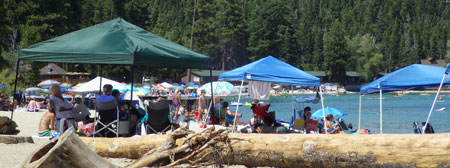
Whereas we're usually pretty much alone there during a weekday, the wonderful beach at Meeks Bay was quite crowded, with plenty of families, kayaks, colorful umbrellas and picnics. A woman had apparently just returned from a dive and so we asked her about the conditions. Pleasant, she said, 63 degrees at shallow depths, more on the surface. Turns out she had her two young kids diving with her. They weren't even ten, and happily prepared for the family's upcoming three-week vacation in Australia, with diving the Great Barrier Reef on the agenda.
Carol and I geared up, expecting the water to be quite cold at depth. We both donned our 7mil wet suits, once again bemoaning the fact that we still hadn't ordered our DUI dry suits (cost!), and I put on my 5-mil shorty with integrated hood on top of that. That's a lot of neoprene. We both used Nitrox; I had one of our big high-pressure Steel-100s, Carol her favorite Steel-80.
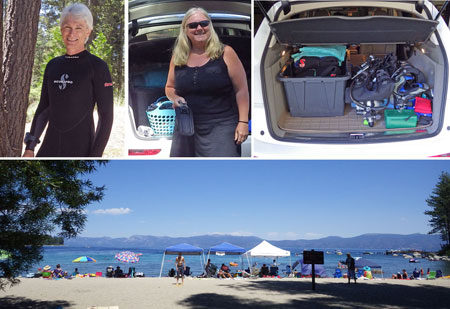
Using the right amount of weight is always an issue. I keep detailed records in my dive log book about the type of gear and amount of weight for every dive, and apparently I had used a full 22 pounds last time I dove fresh water with a steel tank with the 7+5-mil wetsuit combo. I figured I was more experienced now, and decided to go with 18. Carol, who did not have an additional shorty, used 12.
As we stepped into the water I marveled, as I do every time I step into Lake Tahoe, how very clean and clear the water is. There's simply none of the gunk, debris, trash, algae that's almost everywhere else.
The simple logistics of putting on fins, gloves, and mask while standing in a lake are amazingly complicated when wearing all that gear. It's definitely good to have a buddy to steady yourself on, and who holds your stuff while you get ready. And why there does not appear to be a single pair of dive gloves on the planet that goes on easy is beyond me.
Finally we were all done. I felt like a submarine with all the gear, the double layer of neoprene, and the built-in hood. Now it was time to see if I had enough weight to go down. I did.
Once under, the water did look the Tahoe trademark blue rather than the green you encounter in most freshwater lakes and venues, but the visibility was disappointingly low. From many earlier Tahoe dives I remembered being able to see far into the distance. Not this time. There also weren't nearly as many crawdads as we had seen a couple of years ago.
An annoying part of diving with lots of neoprene is that you need a lot of weight to initially go down. But then the neoprene gets compressed, and especially so when you wear two layers, and you start sinking like a stone and need to compensate with bursts of air into your BC. So while the 18 pounds of weight had seemed barely enough to go down, at a depth of just 15 or 20 feet, I needed plenty of air in my BC to get more or less neutral buoyancy. That syndrome, by the way, is exaggerated at Tahoe's high altitude where the neoprene starts out more expanded than it'd be at sea level.
Meeks stays fairly flat for a good while, and so we had a chance to acclimate underwater (our last dives were a coupe of months past) at 20 feet. Then the big rocks begin and there's a fairly steep slop down. At the drop-off we encountered the schools of silvery fish that had thrilled me seven years ago on my first dive at Tahoe. Then we went down along the slope. The water temperature, which had been 68 at the surface and about 63 in the shallow part, stayed in the low 60s down to about 45 feet, then it rapidly dropped. At 77 feet it was in the mid-50s and we leveled off there. It was still quite bright, but the visibility just wasn't good enough to get that wonderful sense of flying and being able to see into the distance. I thought the visibility was no more than 35 feet or so, though after the dive, Carol said she'd been able to clearly see the surface even at 75. A clarity chart recently published by the local Sacramento newspaper seemed to back her up:
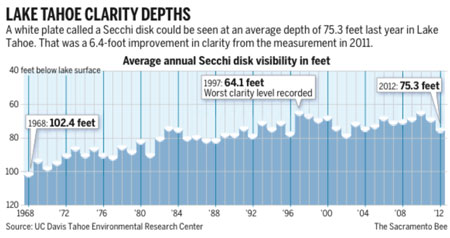
According to the chart, clarity this year is up to 75.3 feet, measured by how far down a white plate can be seen from the surface. 75 feet would be better than any prior time I dove Tahoe, but it simply didn't feel that way. Also, and I may be wrong there, but the big rocks and boulders seemed slimier and more covered in silt than before. That may or may not be so.
The dive, though, was still great. A full 64 minutes during which we sort of drifted off south a bit and then had to work our way back along the shallower shoreline to the beach. I had started with about 3,400 psi, and still had 1,550 at the end of the dive. Carol ended up with roughly the same in her smaller 80-cuft tank.
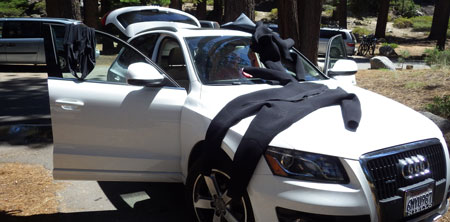
Recovering after a dive is one of my favorite things. You bask in the afterglow of another wonderful underwater experience, enjoy a soda and a snack, putz with the gear, and talk about the dive. Then we packed up all the wet stuff, dried off and changed (a bit of a challenge even in a fairly large SUV), and drove into South Lake Tahoe for a lunch at a place that Carol had loved on a prior visit, but that this time misfired on most cylinders.
On the way back we made a detour to the absolutely gorgeous Echo Lake nestled in the Sierras.
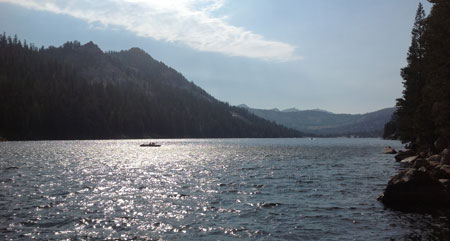
Posted by conradb212 at August 10, 2013 3:47 PM








